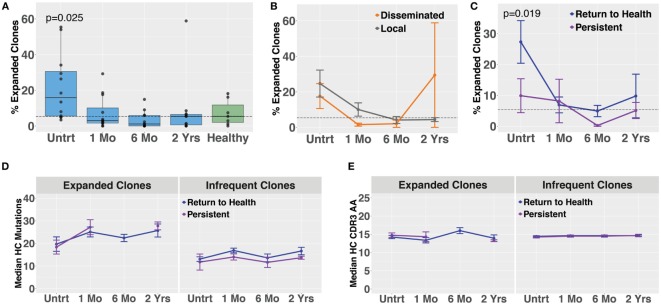Figure 3.
Bulk heavy-chain antibody repertoire sequencing shows increased clonal expansions in untreated Bb-infected humans. Total RNA from peripheral blood mononuclear cells was used for unique molecular identifier barcode-based sequencing of immunoglobulin heavy chains, yielding a mean of 49,293 full-length error-corrected VDJ sequences per subject. Percentage of expanded clones was analyzed across serial time points from the initial (untreated) presentation to 2 years following the completion of doxycycline treatment. (A) Degree of clonal lineage expansion was significantly increased in untreated Lyme disease. Percent clonality was calculated as the percent of clones that expanded to comprise more than 1% of the sequences at a given time point for each patient. (B) Degree of clonal lineage expansion was similar between patients with disseminated and local erythema migrans rash. (C) Patients with a shorter duration of symptoms (return to health) had significantly greater clonality as compared with those who experienced persistent symptoms following treatment. (D) The median number of somatic hypermutations and (E) median CDR3 amino acid lengths were similar between patient groups, for both expanded and infrequent clones. P values are from ANOVA with Dunnett’s (A) or Sidak’s (C) multiple comparisons tests. Dashed lines represent the median value of healthy controls, and error bars represent the SE.

